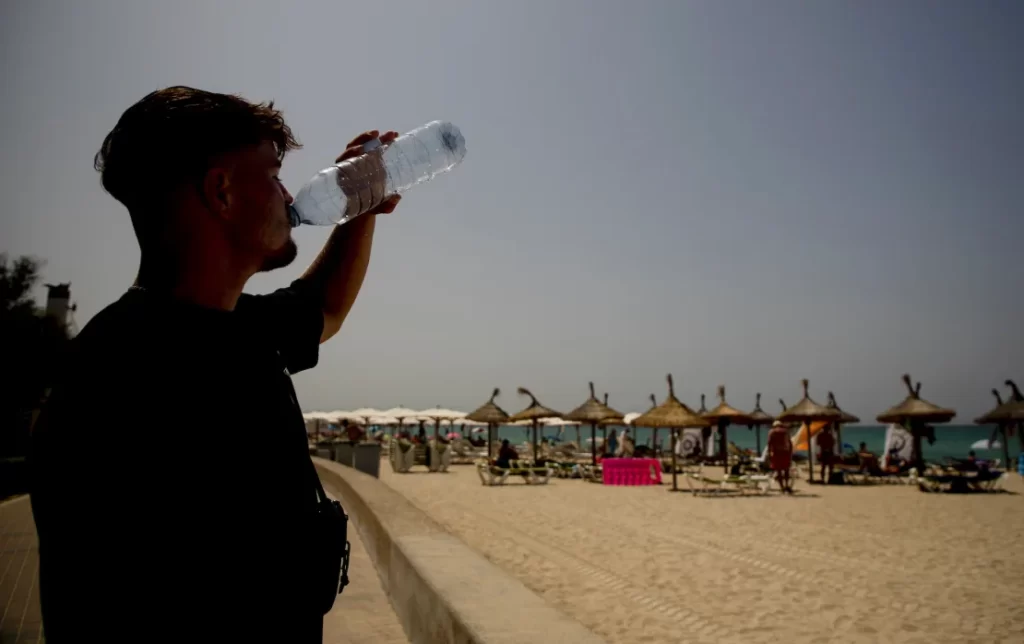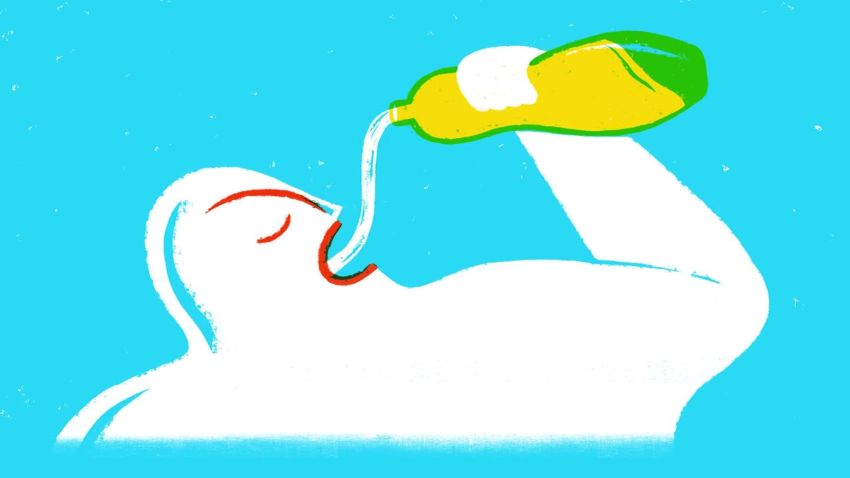In a trailblazing new study, researchers have discovered bottled water sold in stores can contain 10 to 100 times more bits of plastic than previously estimated — nanoparticles so infinitesimally tiny they cannot be seen under a microscope.
At 1,000th the average width of a human hair, nanoplastics are so teeny they can migrate through the tissues of the digestive tract or lungs into the bloodstream, distributing potentially harmful synthetic chemicals throughout the body and into cells, experts say.
One liter of water — the equivalent of two standard-size bottled waters — contained an average of 240,000 plastic particles from seven types of plastics, of which 90% were identified as nanoplastics and the rest were microplastics, according to the new study.
Microplastics are polymer fragments that can range from less than 0.2 inch (5 millimeters) down to 1/25,000th of an inch (1 micrometer). Anything smaller is a nanoplastic that must be measured in billionths of a meter.
“This study, I have to say, is exceedingly impressive. The body of work that they put into this was really quite profound … I would call it groundbreaking,” said Sherri “Sam” Mason, director of sustainability at Penn State Behrend in Erie, Pennsylvania, who was not involved in the study.
The new finding reinforces long-held expert advice to drink tap water from glass or stainless steel containers to reduce exposure, Mason said. That advice extends to other foods and drinks packaged in plastic as well, she added.
“People don’t think of plastics as shedding but they do,” she said. “In almost the same way we’re constantly shedding skin cells, plastics are constantly shedding little bits that break off, such as when you open that plastic container for your store-bought salad or a cheese that’s wrapped in plastic.”
How many nanoplastics are there?
Mason was the coauthor of a 2018 study that first detected the existence of micro- and nanoplastics in 93% of samples of bottled water sold by 11 different brands in nine countries.
In that past study, Mason found each tainted liter of water held an average of 10 plastic particles wider than a human hair, along with 300 smaller particles. Five years ago, however, there was no way to analyze those tiny flecks or discover if there were more.
“It’s not that we didn’t know nanoplastics existed. We just couldn’t analyze them,” Mason explained.
In the new study, published Monday in the journal Proceedings of the National Academy of Sciences, researchers from Columbia University presented a new technology that can see, count and analyze the chemical structure of nanoparticles in bottled water.
Instead of 300 per liter, the team behind the latest study found the actual number of plastic bits in three popular brands of water sold in the United States to be in between 110,000 and 370,000, if not higher. (The authors declined to mention which brands of bottled water they studied.)
However, the new technology was actually able to see millions of nanoparticles in the water, which could be “inorganic nanoparticles, organic particles and some other plastic particles not among the seven major plastic types we studied,” said coauthor and environmental chemist Beizhan Yan, an associate research professor at Columbia University’s Lamont-Doherty Earth Observatory.
The innovative new techniques presented in the study open the door for further research to better understand the potential risks to human health, said Jane Houlihan, research director for Healthy Babies, Bright Futures, an alliance of nonprofits, scientists and donors committed to reducing babies’ exposures to neurotoxic chemicals, who was not involved in the study.
“They suggest widespread human exposures to minuscule plastic particles posing largely unstudied risks,” said Houlihan in an email. “Infants and young children may face the greatest risks, as their developing brains and bodies are often more vulnerable to impacts from toxic exposures.”
Dangers to human health
Nanoplastics are the most worrisome type of plastic pollution for human health, experts say. That’s because the minuscule particles can invade individual cells and tissues in major organs, potentially interrupting cellular processes and depositing endocrine-disrupting chemicals such as bisphenols, phthalates, flame retardants, per- and polyfluorinated substances, or PFAS, and heavy metals.
“All of those chemicals are used in the manufacturing of plastic, so if a plastic makes its way into us, it’s carrying those chemicals with it. And because the temperature of the body is higher than the outside, those chemicals are going to migrate out of that plastic and end up in our body,” Mason explained.
“The chemicals can be carried to your liver and your kidney and your brain and even make their way across the placental boundary and end up in an unborn child,” Mason said.
In studies of pregnant mice, researchers have found plastic chemicals in the brain, heart, liver, kidney and lungs of the developing baby 24 hours after the pregnant mother ingested or breathed in plastic particles, said study coauthor Phoebe Stapleton, associate professor of pharmacology and toxicology at Rutgers University’s Ernest Mario School of Pharmacy in Piscataway, New Jersey.
“Micro and nanoplastics have been found in the human placenta at this point, Stapleton said. “They’ve been found in human lung tissues. They’ve been found in human feces; they’ve been found in human blood.”
In addition to the chemicals and toxic metals plastics may carry, another relatively unstudied area is whether the plastic polymer itself is also harming the body.

Clara Margais/dpa/picture alliance/Getty Images
“The new frontier in plastics is understanding the polymers — the plastic part of plastic,” Mason said. “We’ve been very limited in our ability to understand the potential impact of the polymers on human health because we have not been able to detect down to that level. Now, with this new approach, we will be able to start doing so.”
CNN reached out to the International Bottled Water Association, which represents the industry, for a response to the study’s findings.
“This new method needs to be fully reviewed by the scientific community and more research needs to be done to develop standardized methods for measuring and quantifying nanoplastics in our environment,” a spokesperson for the association told CNN via email.
“There currently is both a lack of standardized methods and no scientific consensus on the potential health impacts of nano- and microplastic particles. Therefore, media reports about these particles in drinking water do nothing more than unnecessarily scare consumers.”
Which plastics are you swallowing?
The study’s new method of identifying nanoparticles in bottled water relies on a modified version of Raman spectroscopy, a laser-based technique that can analyze the chemical composition of cells by measuring how molecules vibrate in response to light.
The altered version, called stimulated Raman scattering microscopy, or SRS, adds a second laser to “amplify the previous signal by several orders of magnitude, allowing the previously unseen nanoparticle to be detected,” said senior author Wei Min, a professor of chemistry at Columbia University in New York City, who coinvented SRS in 2008.
“This study is the first one to apply this microscopy to the nanoplastic world,” Min said.
By dramatically boosting the image, SRS can clearly identify and capture images of nanoparticles in microseconds rather than the hours needed by the older technique — and do so without harming the tissues being imaged.
“But seeing the particles is not good enough because how do you know this is plastic or not? To do that we developed a new machine-based learning technology that allows us to identify and classify which plastic it is,” Yan said.
At the time of publication, the study’s algorithm was able to identify seven types of plastics: polyamide, polypropylene, polyethylene, polymethyl methacrylate, polyvinyl chloride, polystyrene, and polyethylene terephthalate.
“Based on other studies we expected most of the microplastics in bottled water would come from leakage of the plastic bottle itself, which is typically made of PET (polyethylene terephthalate) plastic,” said lead author Naixin Qian, a doctoral student in chemistry at Columbia University.
“However, we found there’s actually many diverse types of plastics in a bottle of water, and that different plastic types have different size distributions,” she said. “The PET particles were larger, while others were down to 200 nanometers, which is much, much smaller.”
Studies have found that particles of PET plastics can be broken off by repeatedly opening and closing the cap of the bottle, crushing the bottle or subjecting it to heat, such as in a car.
Much more research to be done
Now that nanoplastics can be identified and classified, it’s possible to research the answer to all sorts of questions. For example, if the nanoplastics floating in the bottled water weren’t from the bottle itself, where did they come from? The Columbia team is investigating a hypothesis that the other nanoplastics may come from source water, perhaps tainted by some part of the manufacturing process.
Another important question: Which has fewer nanoplastics and chemical residues, bottled or tap water?
“Several studies have reported lower microplastic levels in tap water. Hence, it’s plausible to expect lower nanoplastic levels in tap water as well, considering their common sources,” Yan said. “We’re conducting research on that right now.”
What happens once the plastic polymer and the endocrine-disrupting chemicals enter the body’s cells? Do the invaders remain, wreaking havoc by disrupting or damaging cellular processes, or does the body succeed in kicking them out?
“We know these microparticles are getting into the body, and we know even greater percentages of the smaller nanoparticles are getting into cells, but we don’t know exactly where they’re going in the cell or what they are doing,” Stapleton said. “And we don’t know if or how they’re getting back out again.”
However, the new technology is well-suited to analyzing human tissue samples and should soon provide some answers, Min said.
“If you look at our raw data, it’s actually a series of images,” Min said. “In fact, we have plenty of data to show if a particle has entered a particular location in a certain type of cell, then we will be able to locate it precisely in space.”
While science explores these and other questions, there are things people can do to reduce their exposure to plastics, said Healthy Babies, Bright Futures’ Houlihan.
“We can avoid consuming foods and beverages in plastic containers. We can wear clothing made from natural fabrics and buy consumer products made from natural materials,” Houlihan said. “We can simply take stock of the plastic in our daily lives and find alternatives whenever feasible.”



